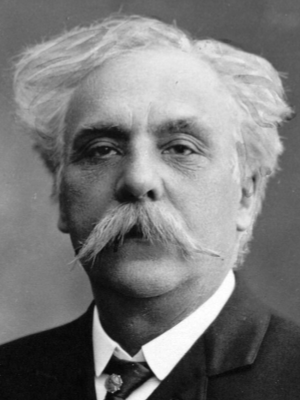Fauré: Requiem in D minor, Op. 48
Lakeview Orchestra will perform Fauré’s Requiem on Tuesday, June 11th at 7:30PM at the Athenaeum Theatre.
Requiem in D minor, Op. 48
Gabriel Fauré (1845 – 1924)
Gabriel Fauré’s musical abilities became apparent at an early age. When the Swiss composer and teacher Louis Niedermeyer (1802 – 1861) heard the boy, he immediately accepted him as a pupil. Fauré studied piano with Camille Saint-Saëns (1835 – 1921), who introduced him to the music of Franz Liszt and Richard Wagner. While still a student, Fauré published his first composition, a work for piano titled Trois romances sans paroles (1863). In 1896 he was appointed church organist at the Church of La Madeleine in Paris and professor of composition at the Paris Conservatory. In 1905 he succeeded Théodore Dubois as director of the conservatory, and he remained in office until ill health and deafness forced him to resign in 1920. Among his students were Maurice Ravel, Georges Enesco, and Nadia Boulanger.
Fauré excelled not only as a songwriter of great refinement and sensitivity but also as a composer in every branch of chamber music. He wrote more than 100 songs, including “Après un rêve” (c. 1865) and “Les Roses d’Ispahan” (1884), as well as song cycles that included La Bonne Chanson (1891–92) and L’Horizon chimérique (1922). He enriched the literature of the piano with a number of highly original and exquisitely wrought works, of which his 13 nocturnes, 13 barcaroles, and 5 impromptus are perhaps the most representative and best known. Fauré’s Ballade for piano and orchestra (1881; originally arranged for solo piano, 1877–79), two sonatas for violin and piano, and Berceuse for violin and piano (1880) are among other popular works. Élégie for cello and piano (1880; arranged for orchestra, 1896), and two sonatas for cello and piano, as well as chamber pieces, are frequently performed and recorded.
Fauré’s Requiem is of special note, since it is unlike any of the compositions that may be considered its peers. The Requiems of Verdi and Berlioz are spectacular works that address the notions of death, resurrection, and final judgment in grand, even theatrical, tones. Smaller in scale, Mozart’s Requiem is filled with great poignancy. Fauré, by contrast, composed a hymn of solace and supplication, music to comfort mourners rather than impress upon them the enormity of death. In some ways, Fauré’s Requiem can even be considered an invitation to death at the end of one’s journey in life. It is a less dramatic, though in no way less moving, setting of the text-- which Fauré himself recognized when he wrote of the composition to the violinist Eugène Ysaÿe (1858 – 1931), claiming that “[e]lle est d’un caractère doux comme moi-meme” (“It is gentle in character, like myself”).
This mildness results as much from what the work does not say as what it does. Among other things, Fauré omits entirely the Dies irae (literally translated, “Day of Wrath”), which normally follows the Kyrie, and which brought forth such terrifying music from Mozart and Verdi. The Verdi Requiem, for instance, uses the Dies irae as an oppressing musical scene of the dead standing before the judgment seat of God. Similarly, Fauré deletes the Tuba mirum, the occasion for mighty antiphonal trumpeting in Berlioz’s Requiem. Instead, Fauré chooses those passages of the Mass for the Dead that serve as prayer and consolation. His theme is always “requiem,” the blessed rest of those whose life’s journey is over. It is understandable that Fauré chose to temper his work in this way. The awesome vision of the Last Judgment would have appealed little to a man whose aesthetic sensibilities were as refined as Fauré’s, and who, moreover, was not a believer. Although he served for many years as organist at the Church of the Madeleine in Paris, the composer was openly agnostic. His skepticism inclined him toward the more generally spiritual aspects of the Mass — whose expression best suited his art, in any case — rather than to suggestive rendering of its scriptural passages. So while his Requiem is certainly a composition for the Church, the spirit of humanism may be heard, at least subliminally, throughout the score.
But even if Fauré’s faith was far from complete, the sentiments conveyed in his Requiem were nevertheless personal and authentic. He began earnest work on this piece in 1886, shortly after the death of his father, and finished it at the end of the following year. Part of the music was heard at the Madeleine in January 1888. Fauré subsequently revised the orchestration, and the composition was heard in its definitive version in 1900. It also was performed at the composer’s own memorial service in 1924. It stands as one on Fauré’s greatest achievements, which is to say that it is one of the finest works in all of French music.
Paradoxically, Fauré’s characteristic use of understatement — manifested in modest themes, delicate textures, harmonic subtlety, and transparent orchestration — accounts for much of this music’s power. His melodies, while exquisite, are simple and chant-like (there is nothing resembling operatic writing in the vocal parts of the work). The orchestra and organ are used with admirable restraint to accompany the singers. The few forceful passages are thus made all the more effective, and the entire score all the more touching, as a result of this generally quiet eloquence.
Lakeview Orchestra will perform Fauré’s Requiem on June 11th, 2019: Learn More or Get Tickets
Program Notes by Luke Smith.

